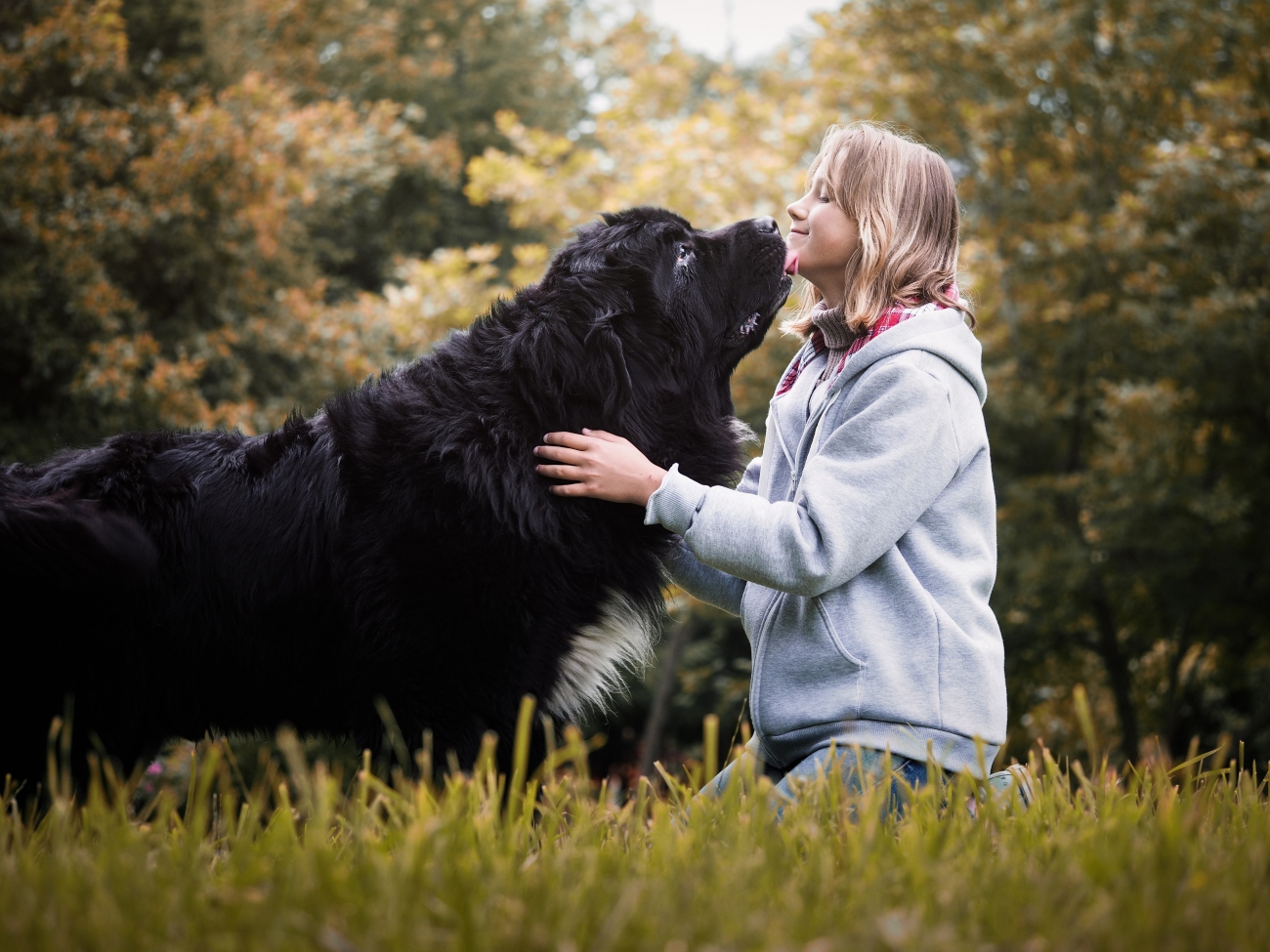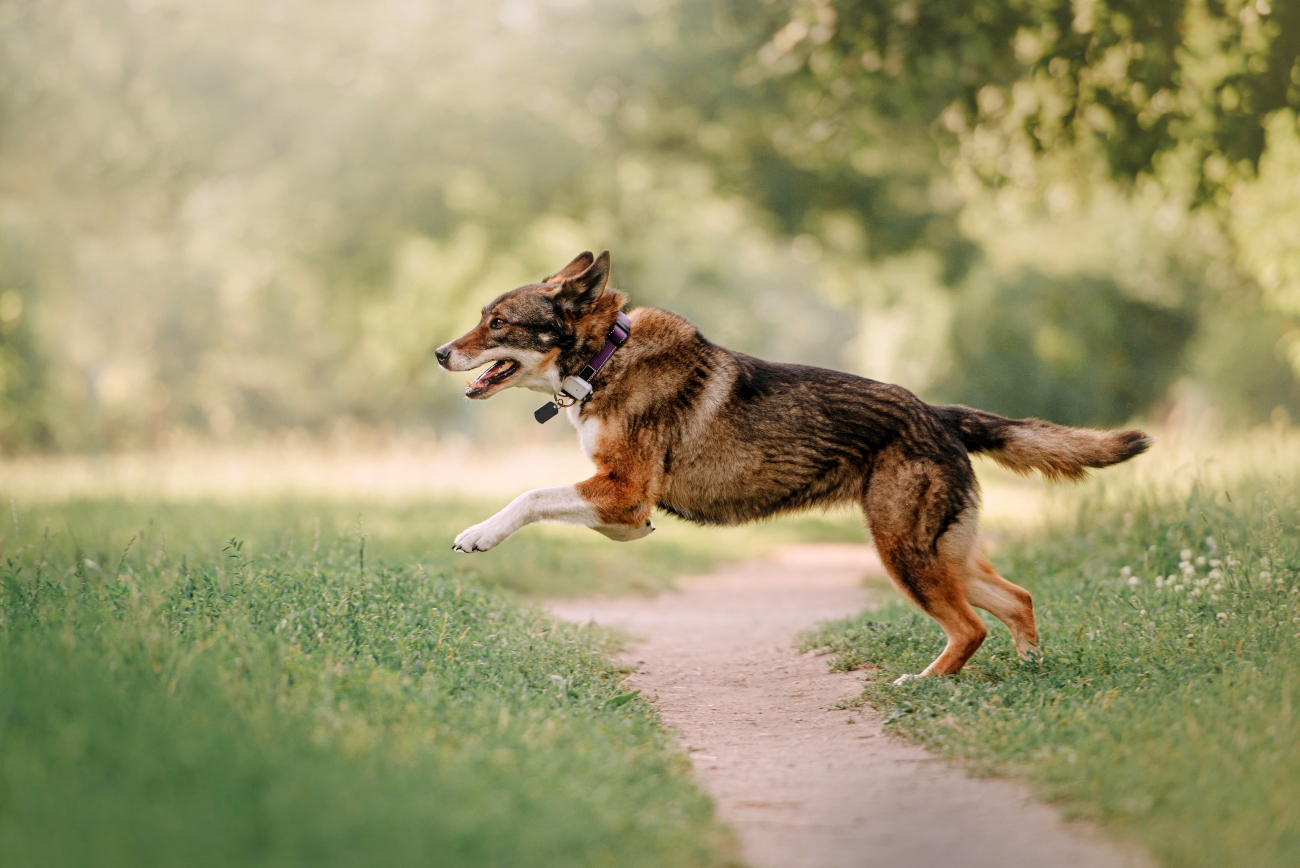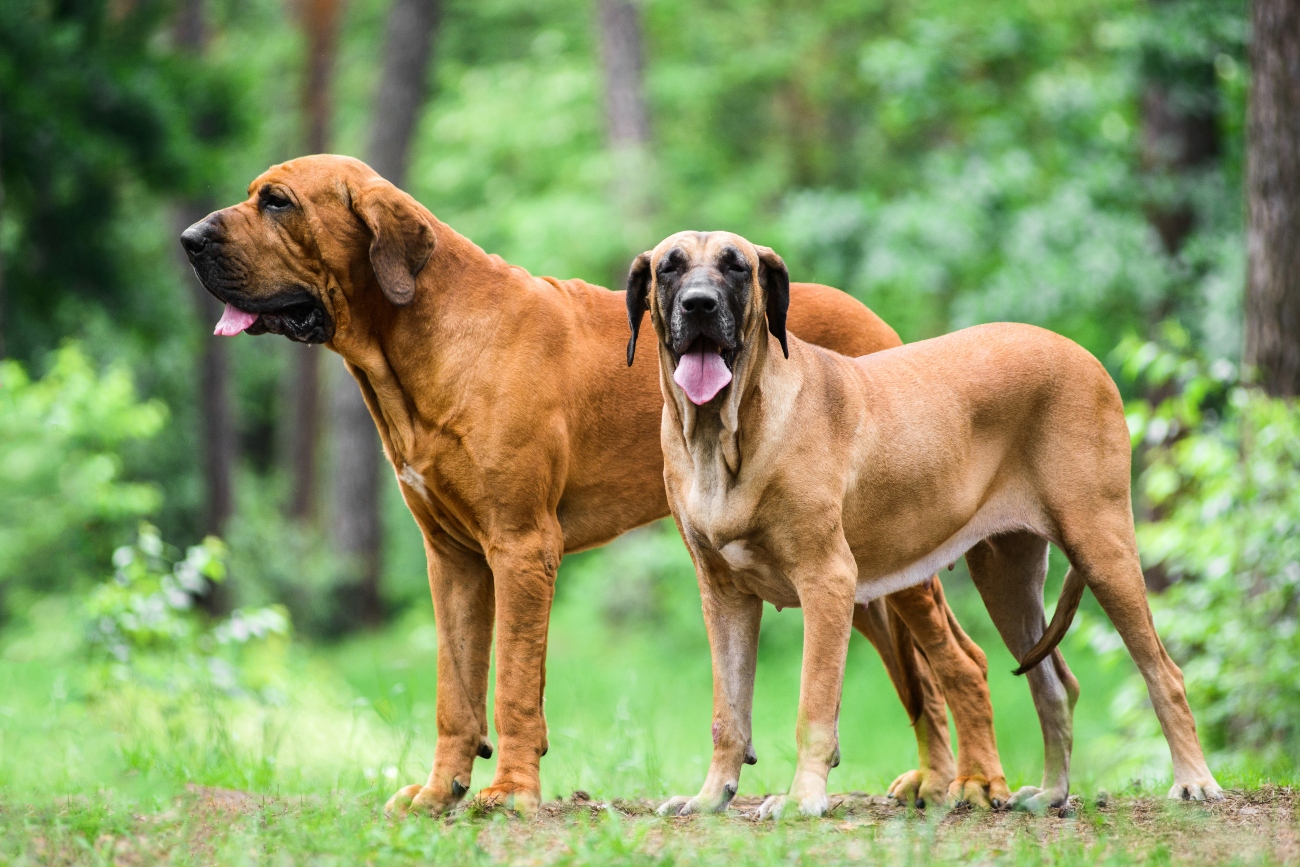
Common health problems in giant dog breeds
30th August, 2022
Don’t be fooled by their extra-large frame – giant breed dogs might look robust but they’re often vulnerable to a range of health problems.
As an owner of a giant breed, or if you’re in the market for one, it’s important that you have an understanding of the kinds of health complaints that could come your way. That way, you can prepare for them in the shape of dog insurance life cover.
The last thing that you want is to be caught unawares, resulting in a hefty vet bill that isn’t covered.
Of course, any animal will pick up their fair share of illness but giant breeds are at risk of developing some very specific health issues. It’s the same for breeds at the other end of the size scale, with ‘handbag dogs’ bringing their own risks.
What are some giant dog breeds?
If you’re an owner of any of the following giant breeds, this article is for you:
- Newfoundland
The Newfoundland breed can measure in excess of 70cm, so you’ll need plenty of space to accommodate one in your home.
- Mastiff
Mastiffs are adored for their calm and good-natured temperament which helps them get on with most people. They usually measure between 71-78 cm tall and these gentle giants will need feeding three or four times a day.
- Great Dane
Great Danes are the ideal mix of intelligence and playfulness. Standing at around 71-76 cm tall, they become a big part of any family.
- Akita
Breeds don’t come much more loyal than Akitas. Originating out of Japan, this imposing and strong breed are typically 61-71 cm in height – matched with their distinctive looks, Akitas never fail to turn heads.
- Dogue de Bordeaux
The Dogue de Bordeaux is a large French mastiff breed, which, unfortunately often don’t live longer than eight years. Given the strength of the bond they form with their owners, it’s a great shame that their size (with an average height of 58-68 cm) tends to cut their life short.
- Saint Bernard
If it's a cuddle monster that you want, a Saint Bernard is your breed. They are extremely affectionate, and measuring between 70-75 cm tall, you’ll certainly feel loved in their company.
- Dobermann
Finally, we have the Dobermann, a large and powerful breed which becomes the heart and soul of every home. They are loyal and intelligent, with a nature that belies their height. They usually measure between 65-70cm.
If you're the proud owner of a large, extra-large or giant breed, there are a range of big dog health problems that you need to be aware of.
Can you expect a shorter lifespan from a giant breed?
Generally speaking, larger breeds live for fewer years than the medium to small breeds. Where some smaller breeds routinely live to be 12-15 years old – save for any major issues – giant breeds don’t usually go beyond a decade.
Obviously, you’ll want to get as many years with your beloved pet as possible, which is why it’s so important to have adequate dog insurance life cover so that you can act on any symptoms without delay.
Otherwise, it’s all about ensuring your giant breed has a high quality diet and, if you can afford it, eats a premium quality dog food formulated for their specific nutritional needs.
It’s easy for large dog breeds to put on weight due to their lumbering size and laid-back nature, so a healthy diet and adequate exercise is necessary to avoid your dog putting on extra pounds.
Carrying excessive weight can exacerbate some of the common problems that giant breeds are prone to, plus leave them vulnerable to heart problems, diabetes and other conditions. Read our recent blog on what are the signs of diabetes in older dogs for more info.
So, if your vet advises that your dog’s weight is creeping up, heed their warning and take action to keep it in check.
Common health problems and symptoms to spot
Bones, joints, muscles and ligaments
Giant breeds can experience bone and joint problems as early as puppyhood, with their extra weight and size putting a strain on their skeletal frame.
Hip and elbow dysplasia are fairly common in these breeds, which can either be caused by malformed or 'poorly fitting' hip joints, or a poor diet, jumping from height, or by too much exercise early in their life.
As well as ensuring that you keep a lid on your excitable pup, make sure you’re buying them from a reputable, responsible breeder as this will help guard against your dog being predisposed to dysplasia.
Other orthopaedic conditions to be on the lookout for from the get-go are panosteitis (often just referred to as 'Pano' or simply growing pains) which is caused by inflammation in your pup’s developing joints.
If your giant pup is showing lameness or limping, without any obvious explanation, it could point to Pano.
Those symptoms could also be a sign of cruciate ligament damage (usually to the back leg in the 'knee' area). In giant breeds, ligament damage can seemingly occur for no obvious reason or it may have happened when your pup was exercising on uneven ground, turned abruptly or took a tumble.
If you notice that your pet’s front legs have a bow to them or ‘knuckle-over’, this might point to Hypertrophic Osteodystrophy (or HOD), which can be brought on by infection, improper diet, vaccine reactions and more. It’s important to catch this one early as it can impact the growth of their joints resulting in malformation.
As an owner of a giant breed, you’ve probably already heard of Wobblers Syndrome, or Spondylolitheses. Giant breeds including Great Danes, Doberman Pinschers and St. Bernards are particularly vulnerable to this syndrome which is caused by a narrowing or malformation of the vertebrae in the dog’s neck.
More common in males than in females, it puts a pressure on the spine, resulting in an awkward, wobbly gait, hence the syndrome’s name.
You need to keep an eye out for this from when your pup is as young as three months old, as it can strike early. But it can also develop in giant dogs in their middle-age or senior years.
Wobblers often puzzles experts in terms of risk factors, but it’s thought that breed and genetics are often to blame’, with too-rapid growth and conformation issues typically at play.
To reduce the pressure on the spinal cord, the vets will often suggest a period of rest – although trying to reduce a puppy’s activity can often prove tough going! Steroids may also be given, and in more serious cases, surgery options could be discussed.
If you have to go down the surgery route, you’ll definitely want adequate dog insurance life cover to help with the costs.
Arthritis
Dogs who experience bone, joint and ligament problems throughout their life are at greater risk of arthritis as they get older. So, given that giant breeds are more predisposed to orthopaedic issues due to their size, arthritis is an obvious concern as your dog moves throughout adulthood.
The key to avoiding arthritis is to keep the weight off your dog as much as possible, so a healthy diet should be maintained throughout the duration of your pup’s life. Adding joint supplements to their diet as they get older will also help, while a memory foam bed will provide the best support for those big heavy limbs and aid rest and recovery.
However, there’s only so much you can do to prevent what can prove to be inevitable, with genetic predisposition to arthritis common in giant breeds.
It’s also thought that early spaying/neutering and rapid growth can contribute to, or accelerate, the onset of arthritic changes.
Symptoms of arthritis include:
- Stiffness
- Limping or lameness
- Lack of mobility
- Increased periods of rest
However, giant breeds can have a high pain threshold, so early signs of arthritis are often not immediately obvious. That’s why regular check-ups at the vets are so important.
If the vet thinks your dog may be showing some early signs of arthritis, they’re likely to suggest some physical therapy such as water therapy.
Your pup may also need to go on some anti-inflammatory medication to keep the condition at bay, too.
Osteosarcoma (bone cancer)
A recent UK study led by the University of Bristol Veterinary School (in collaboration with Cardiff University in Wales, and the Royal Veterinary College of London), revealed how large breed dogs are more susceptible to this painful and aggressive cancer.
Breeds including the Rottweiler, Great Dane and Rhodesian Ridgeback were found to be at the greatest risk of bone cancer, as well as pure breeds who are bred to have long legs and a large body mass. The breeds with the lowest risk of osteosarcoma tumours include the Bichon Frise, French Bulldog and Cavalier King Charles Spaniel.
Symptoms of osteosarcoma include:
- Chronic limping or lameness
- Swelling of bones and/or joints
- Lack of appetite
- Lethargy
- Visible growths on the body
Depending on where the tumour is growing, signs can also include difficulty breathing, walking and eating.
An early diagnosis is key to prolonging life, but treatment options aren’t cheap. The vet is likely to first advise surgery to try and remove the tumour, followed by radiation and/or chemotherapy.
For many owners, being able to progress with this treatment will depend on them having dog insurance life cover.
Heart problems
The bigger the frame, the stronger the heart needed to support it. As well as genetics, illness, infection and even parasites can contribute to heart conditions. And as you might expect, as a dog gets older, the greater the risk of a heart problem.
While they don't suffer heart attacks in the way that we do, they can still develop dangerous – potentially fatal – heart problems that need to be monitored and treated.
Dilated cardiomyopathy
A condition where the heart muscles don’t contract efficiently, leading to an irregular heartbeat (arrhythmia).
With every beat, the heart is having to work extra-hard to pump blood around the body. Not that you’re likely to see many visual effects of this.
A dog can show no obvious symptoms of dilated cardiomyopathy and die suddenly. Any symptoms aren’t likely to seem out of the ordinary, unless you go looking for them.
Symptoms of dilated cardiomyopathy include:
- Excessive panting
- Difficulty breathing
- Fatigue from only a small amount of exercise
If you notice any of the above, a visit to the vets is essential. If they suspect a heart condition, they will send your pup for an echocardiogram, chest x-rays and an EKG to get a full diagnosis.
Aortic stenosis
Another condition more commonly seen in giant breeds, aortic stenosis is a narrowing of the aorta, which over-exerts the heart.
The symptoms of the condition are similar to dilated cardiomyopathy i.e., exhaustion after exercise. So, limiting exercise and stress in affected dogs can help reduce the risks.
Heartworms
Heartworms are as pleasant as they sound – internal parasites which are spread by mosquitoes. If your dog were to pick up a heartworm infestation, you might know about it until the condition is advanced.
If it’s not too late to be effectively treated, you’re looking at a long, painful and expensive route to recovery. Your dog insurance life cover is likely to take a bit of a hit.
Keep up with a monthly heartworm tablet to help prevent this condition.
Other giant breed problems
There are a number of other health conditions which you need to be aware of as an owner of a giant breed.
Hypothyroidism
As you may have guessed, this is a condition of the thyroid gland, where it produces too little of the hormone thyroxine.
While hypothyroidism is not a condition that is exclusive to giant dogs, some breeds – particularly Giant Schnauzers – are found to be at higher risk of disease of the thyroid glands.
Symptoms of hypothyroidism include:
- Unexplained weight gain
- Lethargy
- Thinning hair, darkened skin & itching
Thyroid hormone insufficiency can have severe effects on the welfare of an affected dog due to increased susceptibility to infections and to effects on various organs including brain and kidneys.
Hypothyroidism in dogs is typically treated with hormone supplementation, but you need to be mindful of any side effects.
Bloat or torsion
Bloat or gastric dilatation volvulus is common among large, deep-chested dog breeds. It might sound like a fairly trivial condition, but it is anything but.
Bloat occurs when the dog's stomach stretches due to too much food/water or gas, which can cause it to twist or flip into an unnatural position, essentially restricting the passages between the stomach and the oesophagus and the stomach and the intestines.
It can present a real risk to life, so it’s important that owners do everything to prevent their dogs from eating and drinking too much at once. Unfortunately, dogs, especially giant dogs, can be very ‘good’ at helping themselves to food in cupboards and fridges.
Bloat symptoms include:
- Excessive panting
- Panting or whining
- Drooling
- Retching or dry heaving
- Vomiting
- A swollen belly
Bloat will require immediate treatment, even if that means contacting the emergency animal hospital out of hours.
But, of course, you’ll want to do everything to prevent your pup from experiencing torsion, so you might want to invest in some elevated bowls to aid the eating position.
A ‘go-slow’ bowl is a must-have for dogs which tends to inhale their food, too!
Eye irritation
Big dogs often suffer with their eyes, which causes them great irritation.
Entropion is when the eyelid rolls inwards and the eyelashes irritate the cornea. Ectropion is when the eyelid rolls outwards or droops, resulting in infection, inflammation, conjunctivitis and more.
Both conditions are likely to require some kind of surgery to be corrected – if you’re lucky, you’ll get away with administering eye drops.
As well as entropion and ectropion, giant dogs are prone to ‘cherry eye', which is when the gland in the third eyelid becomes inflamed and enlarged, causing a red, swollen lump to appear in the inner corner of your dog’s eye.
Dog insurance life cover from Petwise

You might have read this article and been left thinking that over the course of a dog’s life, just about anything can go wrong – and you’d be right!
The genetic make-up of giant breeds means that you have additional health risks you need to think about with your dog, underlining the need to take our adequate dog insurance life cover.
Check out our recent blog on the list of banned dog breeds in UK for some further insight.
By taking out cover for your gentle giant for the duration of their – hopefully long – life, you can get on with enjoying your pet, without having to worry about how you’ll afford treatment should they become sick at any point.
With a choice of seven cover levels, we are confident you’ll find dog insurance life cover that’s right for you.
